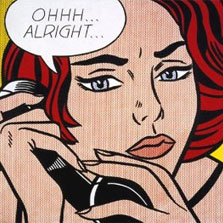| Pop Art History > British | ||||
|
British Pop ArtBritish pop art came about in London in the late 1950's, with a group of painters, sculptors, and other artists who came together to form the Independent Group.The intention behind this group was to challenge current artistic conventions and focus more on a “found art” style that treated cultural objects just as they were and didn't seek to stylize them through any particular lens. These artists received their inspiration from aspects of mass media, such as comic books, commercial advertisements, movies, magazines, and celebrities. Though some “proto-pop” art existed in Europe in the 1940's and predated the Independent Group, they were the firsts to truly incorporate what would eventually be called pop art, and they tended to focus particularly on American mass media and advertisement to draw their inspiration. There was certainly a difference between British pop art and the later American pop art which would emerge from New York and included the likes of Andy Warhol. For one, the British artists viewed the American commercialism that they were parodying through a completely different perspective, since they were not surrounded by it constantly in the same way as Americans were. While British artists tended to focus on creating humorous pieces or on romanticizing their depictions of various objects of mass media, Americans tended to create bolder, less light-hearted work due to their more direct exposure to the source material. Some of the most important painters in the movement were Eduardo Paolozzi, a sculptor and visual artists, surrealist artist Toni del Renzio, and artist Richard Hamilton. All of these men artists were members of the Independent Group and met on a regular basis at the Institute of Contemporary Arts in London during the early 1950's. Paolozzi in particular is often credited with producing the first work of true pop art, a collage entitled I was a Rich Man's Plaything in 1947; though one of the first widely-viewed examples of pop art is Richard Hamilton's Just what is it that makes today's homes so different, so appealing?, which was first show in the exhibition This Is Tomorrow in London. Some of these London-based artists, such as Billy Apple (who was actually originally from New Zealand) would eventually travel overseas and become embedded in the American pop art movement as well, where they would meet and collaborate with the likes of Andy Warhol. It could be said that British pop art arose in part from the Dada movement, a European artistic movement, and it had many other influences in the realm of fine art, which made British pop art uniquely culturally British compared to its American counterpart. Though American mass media was indeed a huge influence, the art that came about in London was very clearly the result of viewing this commercialism through a British lens. The term “pop art” itself was not used by artists until the mid-1950's, though it became a common way to refer to this artistic movement after critic Lawrence Alloway wrote an essay describing it in 1958. Because of this, he is often credited with popularizing or even coining the term. Regardless, the movement eventually spread out of Britain and reached the United States, where it continues in some form or another to this day.

|
|||||||||
| Pop Art History | What is Pop Art? | Origins of Pop Art | American Pop Art | | Independent Group | Artworks Top 10 Famous Artworks | Roy Lichtenstein | Richard Hamilton | Andy Warhol | Timeline | Dictionary | FAQ | Citations | References | Websites Pop Art History - All artworks copyright belong to the artist - Reproduction is strictly prohibited |

